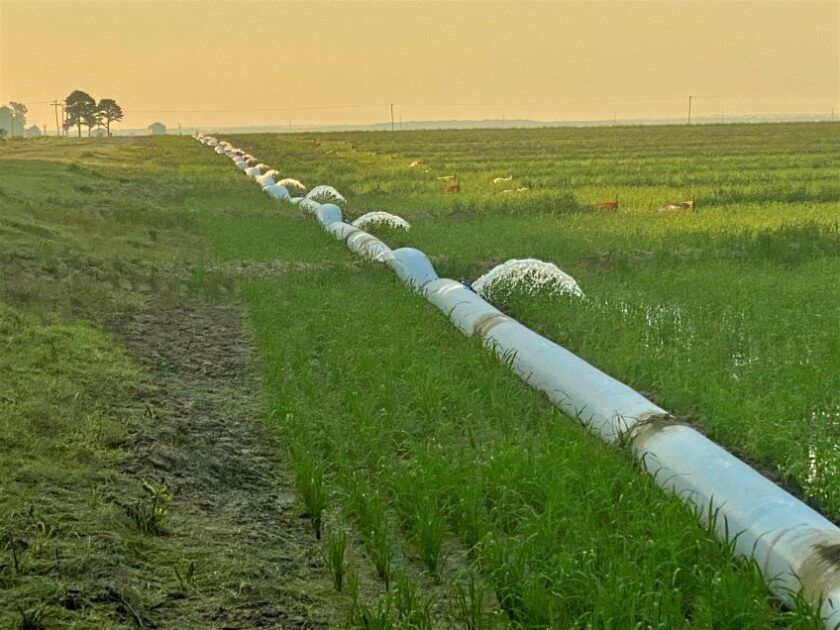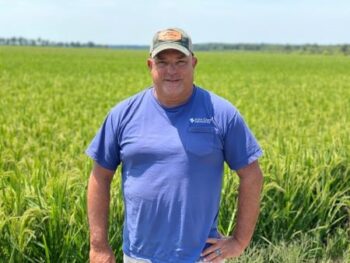
Scott Matthews hails from Weiner in Northeast Arkansas where he grows rice and soybeans in rotation on approximately 1,800 acres (almost 730 hectares) of land. His family has been farming in this area for about 120 years and he has just harvested his 31st crop.
USSA spoke to him about water conservation and some of the innovative irrigation practices he implements on his farm.
 Scott, can you explain why rice is grown in water?
Scott, can you explain why rice is grown in water?
Water does two things for a rice crop. Approximately eight weeks after we plant the rice, we put on a nitrogen shot. That is where almost all of the crop yield comes from. Then we flood the field as quickly as possible. This pushes down the nitrogen and holds it in place. The water suppresses weeds, acting as a barrier to keep the oxygen out of the soil. It also stops the plants from germinating and becoming a problem at harvest time or when we deliver the final product to the mill.
Why is water efficiency such an important issue for you? Am I right in thinking that your farm is in a low water area?
That’s correct. In the past 31 years, we have gone from having good water to low water, which means that our aquifer is depleting and we’re now in what is called the critical groundwater area. But even before that, we saw the vital need to conserve water.
Rice is semi-aquatic. Traditionally, we had a lot of water run off our fields, but it wasn’t regarded as bad practice because water was plentiful and inexpensive. But as time went on, we realized that this was a waste of both resources and money. So, we started building reservoirs and a tailwater recovery system. That meant that when we were irrigating rice or soybeans, our water would go into a tailwater recovery system and back into the reservoir to be reused. And now every year we make changes to conserve either our soil or water in some capacity. I’m never satisfied; I always think that we could and should be doing more to be good stewards.
Can you can you tell us more about some of the improvements you have made over time?
Our ground is naturally flat but it still has to be flooded and one of the techniques we have adopted is called precision leveling, where the ground is mechanically leveled to a grade. This has enabled us to use less water and has also opened the door to other technologies. One of those is called multi-inlet rice irrigation. Basically, after we had precision leveled our fields, we noticed that we were still cascading the flood. That’s when the flood goes from the top and through each field to the bottom and means we aren’t as efficient as we could be. That led us to start using poly tubing which runs along the edge of the fields and involves a calibration process. It’s actually a math problem.
That’s an interesting analogy, Scott. Can you elaborate on what you mean by that?
To ensure that we’re using precisely the right amount of water, we take a number of different measurements as part of our math equation. These include our overall field area as well as the area of each paddy and levee. We also use a flow meter which is attached to the water source we’re using to irrigate that particular crop to give us the gallons per minute flow.
Accuracy is paramount, which is where technology comes in. We use GPS technology and in the past few years have started using a drone. The drone not only helps us to get the acres even more exact, it also measures elevation. This measurement is important because after harvest we will take these data points from our drone and will overlay them with our yield maps. And if we find a spot in a field that’s not getting watered efficiently, even though it has been graded, we’ll go back and correct that problem as soon as we possibly can to increase the overall yield of that field.
And how much water have you been able to save as a result of the technologies that you’ve now implemented?
We’ve reduced our water use by 40%, and it will only get better. Thanks to our irrigation practices, it’s very rare that we run water out of the field during the growing season, which has been one of the greatest benefits. In fact, our tailwater recovery system has actually suffered a little because there’s no longer the same amount of water going into it to be reused.
For me, it’s all about achieving better irrigation efficiency in a critical groundwater area. I know it’s a lot of work and a lot of technology. But any time we can improve by just one percent, it’s going to make a difference to our costs and our yields.


